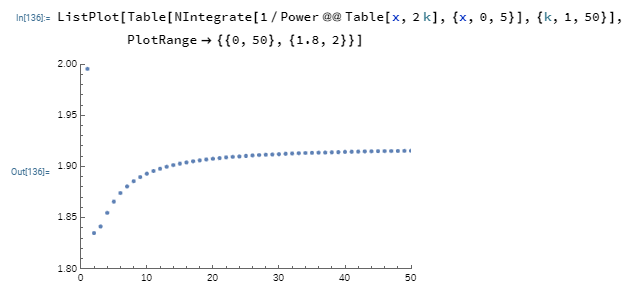Let $h_1(z)=z$, and let $h_{n+1}(z)=z^{h_n(z)}$ so that $h_{2n}(z)$ is the even power tower you are interested in. In this partial answer, I'll show that:
Proposition 1: We have that $$\lim_{n\rightarrow \infty} \int_0^\infty \frac{1}{h_{2n}(x)} dx = C_h=1.91873106\dots $$ where $C_h$ may be expressed exactly as
$$C_h=e^{1−e}+\int_{-1/e}^e\frac{e^{-u}u}{W(u)}du-\int_1^{e}e^{uW_{-1}[-\log u/u]} du$$ where $W$ and $W_{-1}$ are branches of the W-Lambert Function.
Thank you Fred Hucht for pointing out in the comments how to explicitely state the integral involving $W_{-1}$.
I also outline an approach to prove monotonicity.
Proof of Proposition 1
The first thing to note is that $e^{1/e}$ is an important transition point for the integrand. Indeed, the integral should be split into three relevant ranges: $$(1)\ \ \ \ \ \ \ \ \ \ I_1=(0,e^{-e}),\ \ \ I_2=(e^{-e},e^{1/e}), \ \ \ I_3= (e^{1/e},\infty).$$
On $I_3$, the power tower becomes vanishingly small very fast. On $I_2$, it converges, and on $I_1$, we will need to introduce a new function to discuss convergence in the case of $n$ even.
Lemma 1: For any $x\in I_2$, $$\lim_{n\rightarrow\infty}h_n(x)=\frac{W(-\log x)}{-\log x}$$ where $W$ is the W-Lambert Function. Alternatively, this equals $u$ where $u$ is the unique value such that $u^{1/u}=x$.
Proof: See Exponentials Reiterated.
At first glance, it is surprising that $1.4^{1.4^{1.4^{\dots}}}$ converges, but it does indeed converge.
To extend this Lemma to $I_1$, we need to restrict to $n$ even, and define the following inverse function:
Definition 1: For $x \in (0,e^{1/e})$, let $L(x)$ denote the unique point $u$ such that $\frac{1}{e}\leq u \leq e$ and $x^{x^u}=u$.
With this definition in mind, we have the following Lemma:
Lemma 2: For any $x \in (0,e^{1/e})$, $$\lim_{n\rightarrow \infty} h_{2n}(x) = L(x).$$ For $0<x<1$, this limit is approached from above, and for $1<x<e^{1/e}$ this limit is approached from below.
Proof: See Exponentials Reiterated.
In particular, due to the monotonicity on the different ranges, Lemma 2 implies uniform convergence, and hence $$\lim_{n\rightarrow \infty}\int_0^{e^{1/e}} \frac{1}{h_{2n}(x)}dx=\int_{0}^{e^{1/e}}\frac{1}{L(x)}dx.$$
Lastly, we note that the integral over $I_3$ tends to zero very quickly. Indeed:
Lemma 3: We have that $$\lim_{n\rightarrow \infty}\int_{I_3} \frac{1}{h_{2n}(x)}dx =0.$$
Proof: For $\epsilon>0$, there exists $N$ such that for $n>N$, $h_{2n}(e^{1/e}+\epsilon)>\frac{1}{\epsilon}$. Hence we can split into ranges $(e^{1/e},e^{1/e}+\epsilon)$, $(e^{1/e}+\epsilon,2)$, and $(2,\infty)$, and obtain a bound of $C\epsilon$ for some fixed constant $C$.
All together, Lemma's $1$, $2$, and $3$ imply the following Proposition, which implies Proposition $1$:
Proposition 2: We have that $$\lim_{n\rightarrow \infty}\int_0^{\infty} \frac{1}{h_{2n}(x)}dx=\int_{0}^{e^{1/e}}\frac{1}{L(x)}dx.$$
$$ = \int_{0}^{e^{-e}}\frac{1}{L(x)}dx + \int_{e^{-e}}^{e^{1/e}}\frac{-\log x}{W(-\log x)}dx.$$
There are a few ways to clean up this second integral, such as $$\int_{e^{-e}}^{e^{1/e}}\frac{-\log x}{W(-\log x)}dx = \int_{\frac{1}{e}}^{e}\frac{1}{x}x^{\frac{1}{x}}\left(\frac{1}{x^{2}}-\frac{\log x}{x^{2}}\right)dx$$
$$=\int_{-1}^{1}e^{-2u}e^{e^{-u}u}(1-u)du.$$
Fred Hucht pointed out in the comments that the integral $\int_{0}^{e^{1/e}}\frac{1}{L(x)}dx$ can be expressed in terms of $W_{-1}(x)$, a different branch of the W-Lambert function, in the following way:
$$\int_{0}^{e^{-e}}\frac{1}{L(x)}dx = e^{1−e}-\int_1^{e}e^{uW_{-1}[-\log u/u]} du.$$
This implies the exact expression:
$$\lim_{n\rightarrow \infty}\int_0^{\infty} \frac{1}{h_{2n}(x)}dx = e^{1−e}+\int_{-1/e}^e\frac{e^{-u}u}{W(u)}du-\int_1^{e}e^{uW_{-1}[-\log u/u]} du.$$
Monotonicity
For $0<x<1$, $h_{2n}(x)$ is monotonically decreasing as $n$ increases. For $1<x<e^{1/e}$, it is monotonically increasing. I believe that these two effects can be combined together in the following way. Consider $$\int_{I_2} \frac{1}{h_{2n}(x)}dx=\int_{-\frac{1}{e}}^{e}\frac{e^{-u}}{h_{2n}(e^{-u})}du.$$ Splitting at $x=1$, which corresponds to $u=0$, this decomposes into $$\int_{0}^{e}\frac{e^{-u}}{h_{2n}(e^{-u})}du+\int_{0}^{\frac{1}{e}}\frac{e^{u}}{h_{2n}(e^{u})}du=\int_{0}^{1}\frac{e^{-eu}}{h_{2n}(e^{-eu})}edu+\int_{0}^{1}\frac{e^{u/e}}{h_{2n}(e^{u/e})}\frac{1}{e}du$$
$$=\int_{0}^{1}\left(\frac{e^{1-eu}}{h_{2n}(e^{-eu})}+\frac{e^{u/e-1}}{h_{2n}(e^{u/e})}\right)du.$$
Claim 1: The function $$\frac{e^{1-ex}}{h_{2n}(e^{-ex})}+\frac{e^{x/e-1}}{h_{2n}(e^{x/e})}dx$$ is monotonically increasing in $n$ for $0<x<1$ and for $n>3$.
Monotonicity would then follow from a combination of:
- Stronger quantitative bounds on the integral over $I_3$.
- A proof of Claim 1.
- The fact that $h_{2n}(x)$ converges to $L(x)$ from above on $I_1$.
The convergence from above on $I_1$ should outweigh the error on $I_3$.


